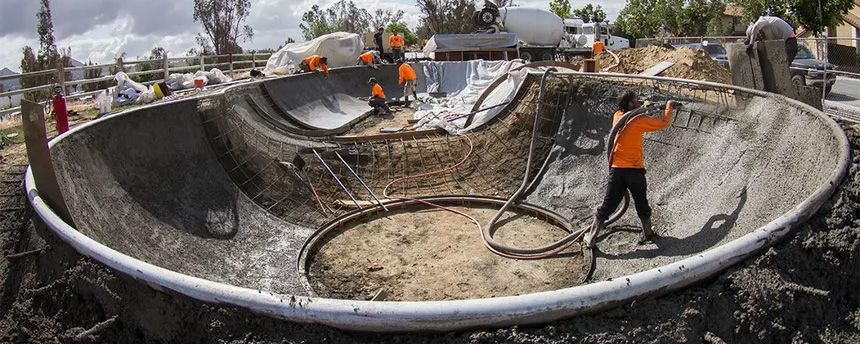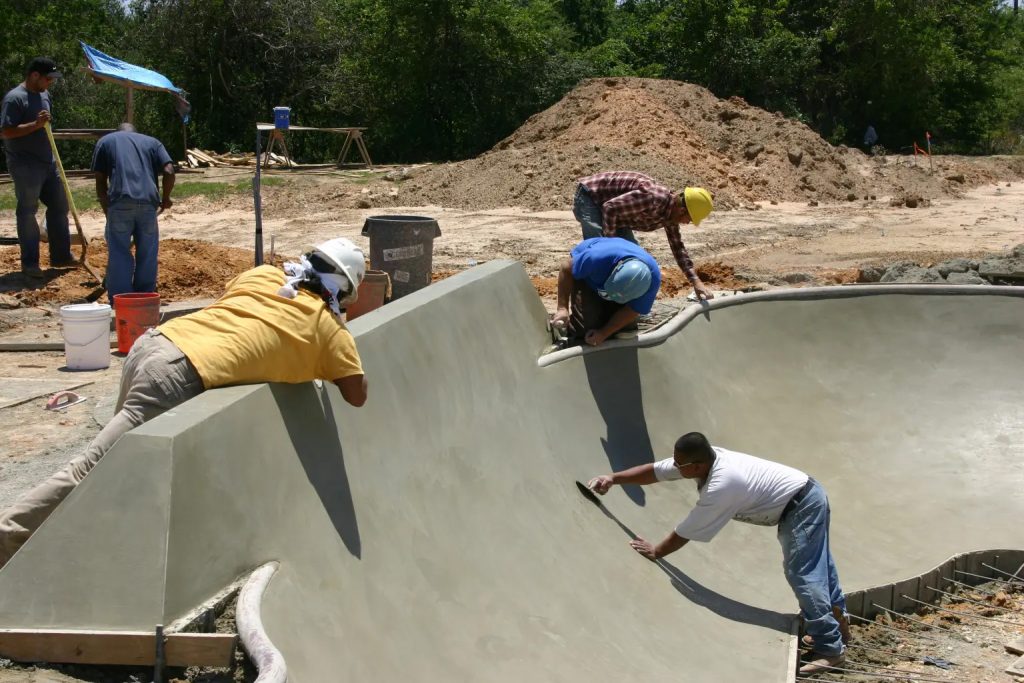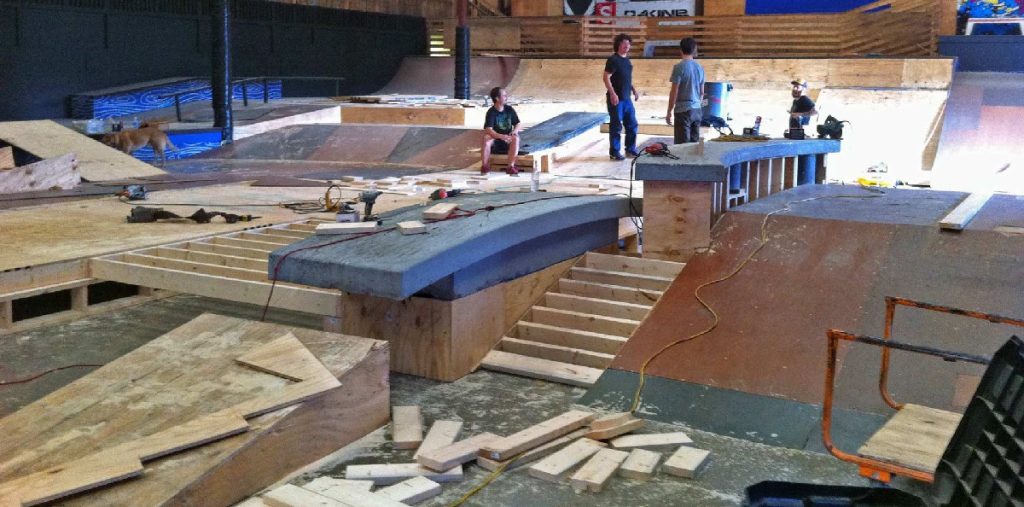How to Get a Job in Skatepark Construction
Working in skatepark construction is more than just a job—it’s an opportunity to be part of skateboarding in a meaningful way. Instead of skating parks built by others, you’ll be creating the spots that skaters will ride for decades. This industry values hard work, practical skills, and a deep understanding of skateboarding culture.
Skatepark construction crews are made up of skaters, builders, and craftsmen who take pride in their work. Companies prefer to hire people who know how a park should flow, making skateboarding experience a major advantage. Whether you have construction experience or are starting from scratch, this guide will walk you through the skills, application process, and best ways to get hired.
What to Expect in Skatepark Construction Jobs
Skatepark construction is a hands-on, fast-moving career that requires travel, long hours, and physical endurance. Crews move from one project to the next, often working in different cities, states, or even countries. The work itself is labor-intensive, involving digging, forming concrete, welding, and carpentry. Precision and craftsmanship are key, as even small mistakes can affect how a park skates.
This job is not for everyone—it requires commitment, adaptability, and a willingness to push through tough conditions. However, those who stick with it gain valuable trade skills, travel opportunities, and the satisfaction of building parks that will leave a lasting impact on the skateboarding community.
Life on the Road as a Skatepark Builder
Skatepark construction is not a typical 9-to-5 job. Crews move from project to project, often working in different cities or states. The lifestyle is fast-paced, requiring flexibility and a willingness to adapt to changing locations and conditions.
- Builders travel from city to city, much like a skate team on tour.
- Expect to stay in shared hotel rooms, campsites, or other temporary housing.
- Most crews are made up of skaters who understand park design and flow.
- The job is physically demanding, requiring long hours in outdoor environments.
- Projects can last anywhere from a few weeks to several months, depending on size and complexity.
The Reward of Building Skateparks
Skatepark construction is challenging, but the rewards go beyond just a paycheck. Unlike typical construction jobs, every project leaves a lasting impact on a community. Builders take pride in creating parks that skaters will enjoy for decades, knowing that their work helps grow skateboarding culture. Many projects also involve collaborating with pro skaters and industry leaders, making it a unique and fulfilling career.
- Seeing a local scene grow around a park you helped build is an incredible feeling.
- You’re building something lasting—parks that skaters will ride for decades.
- Create legendary spots that become part of skateboarding history.
- Some companies work on Olympic parks, X Games courses, and Street League Skateboarding (SLS) venues.
- Meet and network with skateboarding insiders, including pro skaters, team managers, brand reps, and event organizers.
- Be part of a tight-knit industry where connections lead to future opportunities.
The Physical Demands of the Job
Skatepark construction is physically strenuous and requires long hours of manual labor in all types of weather conditions. Builders need endurance, strength, and attention to detail to ensure parks are both durable and skateable. The job involves a mix of heavy lifting, precision work, and operating specialized equipment, making it a highly skilled trade. Those who excel in this field develop expertise in concrete finishing, welding, and carpentry—valuable skills both in and outside the skate industry.
- Expect long hours and tough manual labor in physically demanding environments.
- Work outdoors in all weather conditions, including extreme heat, cold, rain, and wind.
- The job can be dangerous, so safety training and proper gear are essential.
- Common tasks include:
- Digging & site preparation – Clearing land and preparing the foundation.
- Concrete pouring & finishing – Mixing, spreading, and smoothing concrete for ramps and bowls.
- Welding & metalwork – Installing rails, coping, and reinforcement structures.
- Operating heavy machinery – Using excavators, loaders, and concrete trowel machines.
How Much Do Skatepark Builders Make?
Skatepark construction offers competitive pay, especially for those with specialized skills like concrete finishing and welding. Most jobs start at an hourly wage, with rates increasing based on experience, skill level, and the company. Since many builders travel for work, some companies also cover travel expenses, lodging, and per diem costs, making it easier to take on jobs in different locations. While entry-level positions focus on manual labor, experienced builders and project managers can earn significantly higher wages.
- Entry-level pay – $15–$30 per hour, depending on experience.
- Project managers & designers – Can earn $60,000–$100,000+ per year, depending on experience.
- Additional benefits – Many companies cover travel expenses, lodging, and sometimes per diem meals for workers on the road.
- Freelance & contract work – Many builders work for multiple companies throughout the year, allowing them to take on projects that fit their schedule.
- Skilled labor – Earn higher wages based on experience in concrete finishing, welding, and heavy equipment operation.
Skills Needed for Skatepark Construction
Developing hands-on skills will improve your chances of getting hired and advancing in the field. A mix of construction techniques and design knowledge makes you a more valuable worker. Here are the most valuable skills that will help you stand out.
- Concrete Work – Pouring, shaping, and finishing concrete.
- Carpentry – Building wood ramps, framing concrete forms.
- Welding & Metalwork – Installing rails, coping, and structural supports.
- Heavy Equipment Operation – Running excavators, loaders, and trowel machines.
- Landscaping – Preparing and grading sites, erosion control, and drainage.
- Blueprint Reading & Design – Understanding blueprints to take on leadership roles.
- CDL (Commercial Driver’s License) – Required for operating trucks that transport heavy equipment.
- CPR & First Aid Certifications – Ensures safety on job sites and may be required by employers.
How to Get Hired in Skatepark Construction
Before applying for jobs, have a clear strategy to increase your chances of getting hired. The skatepark construction industry is competitive, and companies look for workers who are motivated, reliable, and skilled. Start by researching different companies, following their social media, and understanding the types of projects they specialize in. Many companies post job openings on Instagram stories or hire based on recommendations, so staying engaged with the industry is essential.
When reaching out, be professional and direct. A well-crafted message that highlights your skills, willingness to travel, and previous experience (even if it’s DIY skatepark work) will stand out. Persistence is key—if a company isn’t hiring now, stay on their radar by checking in periodically and staying involved in the scene.
- Create an Online Presence – Employers check Instagram for skate clips, DIY builds, and industry involvement.
- Tailor Your Resume – Highlight relevant trade skills like carpentry, welding, and concrete work.
- Be Professional – Even though it’s a skateboarding job, respect and professionalism matter.
- Network Effectively – Use direct messages and emails to connect with decision-makers.
- Be Ready for the Call – Many jobs require immediate availability, so be prepared to travel on short notice.
- Stay Persistent – If you don’t get hired immediately, follow up and stay on their radar.
Where to Apply for Skatepark Construction Jobs
Knowing where to apply is just as important as having the right skills. Unlike traditional construction jobs, skatepark construction companies rarely post job listings on mainstream job boards. Instead, hiring happens through direct outreach, social media, and industry connections. Many companies are looking for workers but rely on referrals and word-of-mouth rather than public job postings.
If you’re serious about getting into the industry, focus on these key places to find opportunities.
- Use Direct Contact Methods – Call, email, or DM companies directly.
- Check Company Websites – Some companies list jobs on their career pages.
- Follow Instagram Pages – Many companies post job openings in their stories.
- Network Within the Industry – Attend grand openings, trade shows, and events to make connections.
- Be Persistent – Keep checking in weekly until a job opens up.
Final Thoughts and Motivation
If you’re passionate about skateboarding, why not turn that passion into a career? You don’t have to be a pro skater to make a living in the skate industry. Less than 1% of professional skaters make millions, and fewer than 5% earn six figures. Most pros barely scrape by and rely on side jobs to stay afloat. But the good news is that there are plenty of opportunities in skateboarding beyond being a pro.
Skatepark construction is one of those opportunities. It allows you to stay connected to skate culture, travel, and build something lasting. The parks you help create will be skated for generations, becoming part of the landscape of skateboarding itself. As you gain experience, you’ll meet industry insiders, work alongside pros, and develop skills that can lead to even bigger opportunities.
The companies listed in this guide are actively building parks and hiring workers. This is your entry point.
Skateboarding has never been about following a traditional path—it’s about pushing limits and making your own way. The same goes for working in the skate industry. The opportunities are there, but it’s up to you to take the first step. Reach out, follow up, and make it happen.
Shotcrete Skatepark Application

Skatepark Concrete Finishing

Wood Skatepark Carpentry
